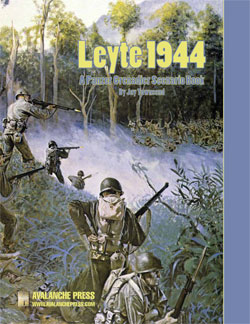| Leyte 1944:
Japan’s Battalions
By Mike Bennighof, Ph.D.
June 2020
 Lacking the industrial resources to field large numbers of tanks or artillery, the Imperial Japanese Army of World War II relied on its infantry to provide its striking power. The Japanese foot soldier was expected to overcome his emperor's enemies through superior training, physical conditioning and most of all through superior will. The early years of the China Incident seemed to confirm this path. But patriotism and devotion to the emperor could only do so much to offset the massive firepower advantage that Soviet, British and especially American troops could bring to bear. Lacking the industrial resources to field large numbers of tanks or artillery, the Imperial Japanese Army of World War II relied on its infantry to provide its striking power. The Japanese foot soldier was expected to overcome his emperor's enemies through superior training, physical conditioning and most of all through superior will. The early years of the China Incident seemed to confirm this path. But patriotism and devotion to the emperor could only do so much to offset the massive firepower advantage that Soviet, British and especially American troops could bring to bear.
On paper, a Japanese infantry company was almost identical in strength to its American equivalent: 194 men for the Japanese against 192 Americans. Each rifle company had three platoons, with each platoon counting 44 riflemen, three light machine guns and three 50mm grenade dischargers, the unique weapon known to the Americans as the "knee mortar." Each battalion had four rifle companies, compared to three in the American battalion, but the Japanese unit had nowhere near the scale of combat support afforded to Allied infantry.

The battalion's heavy weapons company only had two platoons each of four heavy machine guns, and no mortars. Instead, fire support came from a pair of Type 92 70mm infantry guns; later in the war two 37mm anti-tank guns would be added to many battalions. Because of the lack of motor vehicles, Japanese infantry units also had an inordinately large number of men detailed to haul ammunition.
Little more support could be expected at the regimental level. The Japanese infantry regiment counted three infantry battalions, a regimental cannon company with four 75mm guns and an anti-tank company with four or six 37mm guns. The division controlled engineer and reconnaissance battalions (styled "regiments") and would often attach assets for special operations, not only from these battalions but even rifle companies from other regiments.

The Imperial Navy's Special Naval Landing Forces were battalion-sized units with a very different table of organization than that of the Army's battalions. They had fewer companies, but each was much larger than the equivalent Army unit as the rifle companies were expected to fight independently if necessary. The Navy also appears to have used oversized formations to obscure just how many foot soldiers it had enrolled, hiding the total from its Army rivals as well as its political overlords. Rifle companies had six rifle platoons in 1940, with some of the SNLF units dropping to four platoons per company by 1942. The platoons were larger than the corresponding Army units, with 52 men but the same number of machine guns and grenade dischargers. Each company also had a machine-gun platoon, though it was twice the size of the Army's machine gun platoon and so is represented in Panzer Grenadier by two pieces.

The battalion also included a "heavy weapons company" that amounted to an artillery detachment: two 70mm infantry guns, two 75mm howitzers, and four 76.2mm naval guns. They also had three rifle platoons of their own. Armament varied, and in some forces the heavy weapons company had 81mm mortars instead of infantry guns or howitzers or both. Some forces only had one heavy weapons company, while others received two.
Even more than was the case with the Army's battalions, SNLF organization varied from unit to unit. In addition to mortars, SNLF units could also include 47mm anti-tank guns, 25mm anti-aircraft guns or anti-aircraft machine gun platoons in their heavy weapons companies.
Despite the constant cross-attaching of units, Japanese formations held together remarkably well during the Pacific War. The hard pre-war training helped, as well as a cohesive officer corps. But no amount of courage and fanaticism could overcome equally courageous troops backed by overwhelming firepower.
Send the Japanese into battle in Saipan 1944, available now!
Click here to order Leyte 1944.
Please allow an additional four weeks for delivery.
Sign up for our newsletter right here. Your info will never be sold or transferred; we'll just use it to update you on new games and new offers.
Mike Bennighof is president of Avalanche Press and holds a doctorate in history from Emory University. A Fulbright Scholar and NASA Journalist in Space finalist, he has published eleventy-million books, games and articles on historical subjects.
He lives in Birmingham, Alabama with his wife, three children, his dog Leopold and Egbert the pet turkey.
|
